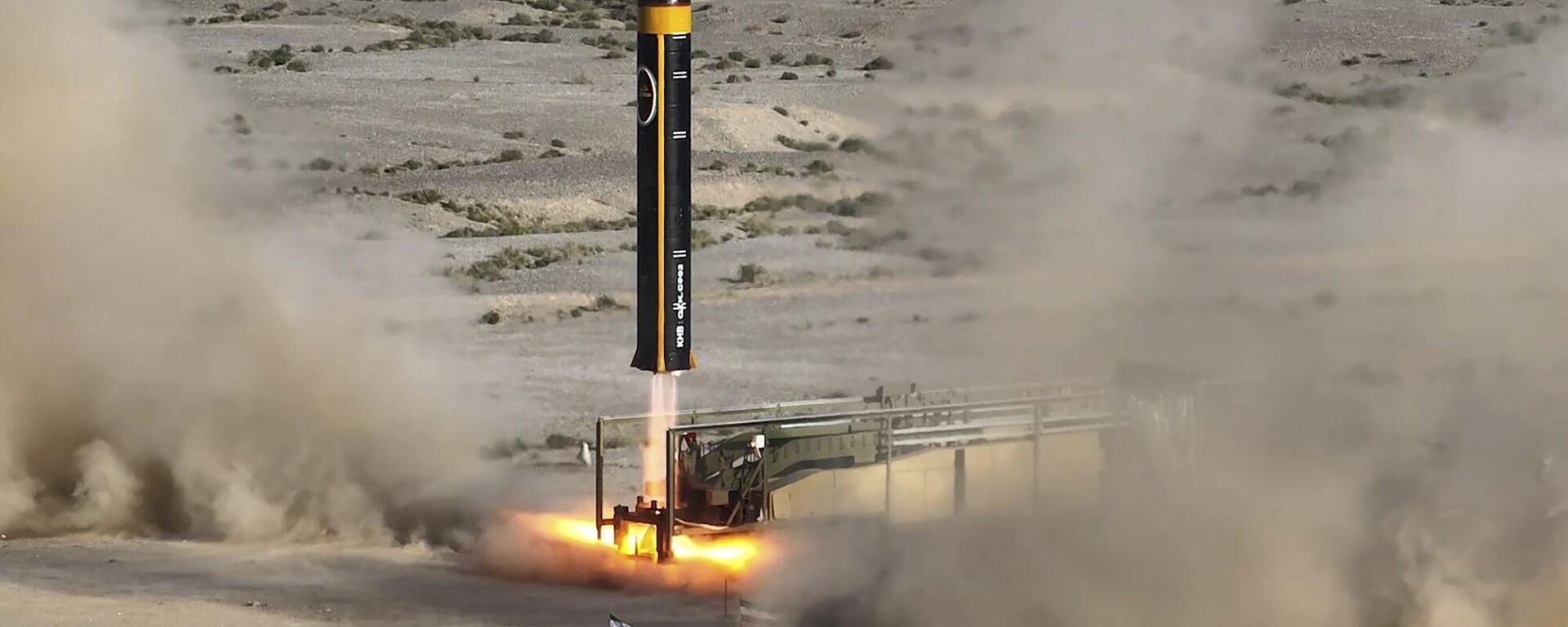Trump's Iran Ambitions: Bluff, Deterrence, Or Speculative Geopolitics?

© AP Photo / Evan Vucci
Subscribe
US President Donald Trump has warned Iran that military action was "absolutely" inevitable if discussions failed to halt the Islamic Republic's nuclear programme. Sputnik India assesses what's at work here.
Attacking Iran militarily could result in a catastrophe for the US, as the Middle East state possesses a world-class arsenal of armed drones and a wide variety of missiles, including hypersonic capabilities, experts have said.
Iran has an extremely potent drone industry, with the Shahed-136 being used by Russia to launch a large number of attacks on the Ukrainian military. Also, Tehran has developed Shahed-238, which is believed to have the potential to track down the American MQ-9 Reaper drones in the sky, Major General (Retd) Prabdeep Singh Behl, highlighted.
"Besides, it has the Kaman-22, which is the equivalent of the US Predator drone, and has a range of 1,860 miles, putting all American assets in the Middle East within striking distance. The fact is that the number of drones that Iran has in its inventory, especially long-range loitering munitions, poses a significant threat to US interests in the MENA region," the Indian Army veteran told Sputnik India.
Additionally, Iran's missile technology is quite advanced, with Tehran in possession of hypersonic, cruise, and anti-ship missiles that can be used to target American naval vessels in the region, he added.
Nonetheless, Trump's continuous threats to Iran are part of a broader geopolitical work at play. That's why all this movement of US military assets, including the deployment of B-2 bombers, is nothing but pressure tactics to kind of bully Iran into a direct deal with America. It is more of a bluff, but the Iranians are smart enough to resist a direct deal with the US, Behl reckoned.
Washington's decision to deploy B-2 stealth bombers at Diego Garcia and the aircraft carrier USS Carl Vinson to the Middle East has raised the stakes, yet is too far from potentially striking against Iran and risk heightening tensions, believes Anant Mishra, a Marie Curie Research Fellow at the International Centre for Policing and Security (ICPS), University of South Wales.
But even entertaining the idea of Washington giving a thought to potentially launching a military strike on Iran, the whole scenario is far more complex and high risk, even for Tel Aviv and Washington to contemplate the risks through various simulations, he pointed out.
"Importantly, naval aviators will unlikely volunteer for a mission that guarantees no return. Even if Washington is able to maintain certain elements of surprise, their momentum would be lost the moment it strikes a target, even successfully in Iran," Mishra said in an interview with Sputnik India.
Leave alone air assets neutralising surface-to-air sites or critical infrastructure, Washington's decision to potentially dismantle Iran's nuclear program, essentially carpet bombing critical sites, storage facilities, would involve much larger resources than B-2 bombers, the strategic affairs pundit explained.
To even entertain the idea of partial success, Washington needs to destroy all possible airbases, to maintain aerial dominance, perpetually cripple Islamic Revolutionary Guard Corps' (IRGC) command centres, and neutralise all possible anti-air assets, which would require aviators to cross Iranian airspace in multiple flight paths.
Even extending such a hypothesis, Washington would require more than a bunker buster to destroy Iran's buried nuclear facilities, he underscored.
"The option of employing/relocating aircraft carriers for sorties could possibly reflect one solution to the 'sortie' problem, but protecting them from Iran's drones, mines, fast attack boats, and anti-ship missiles could pose a serious challenge. That said, Washington's arsenal does involve assets and ammunition catered to target Iranian strategic locations from 400 miles away in the northern Indian Ocean, putting it outside the retaliatory zone, but this move itself appears far-fetched," Mishra observed.
Trump's potential plan to strike Iran is more than a military maneuver—it's a high-stakes mix of deterrence, political ambition, and speculative geopolitics, says Dr. Shubhda Chaudhary, founder of the New Delhi-based Middle East Insights Platform.
On the surface, the goal is to halt Iran's nuclear ambitions. Since Trump withdrew from the 2015 nuclear deal, Tehran has enriched uranium to 90% purity—approaching weapons-grade—though its delivery systems remain unclear, she elucidated.
"The deployment of B-2 bombers to Diego Garcia, armed with GBU-57 bunker-buster bombs capable of destroying underground Iranian nuclear facilities like Fordow, signals readiness. Diego Garcia, 3,500 kilometers from Iran, plays a key strategic role. While known for hosting B-2 bombers, it may also serve as a base for a naval blockade of the Strait of Hormuz, threatening Iran's oil exports. US submarines and drones have expanded their presence, but British complicity—given the UK's sovereignty over the island—remains opaque," Chaudhary argued in a conversation with Sputnik India.
At the same time, Trump's strategy doesn't question Israel's nuclear opacity, despite the region's strategic imbalance. Pressure from Israeli Prime Minister Benjamin Netanyahu may be pushing the US toward conflict, with potential side benefits extending far beyond Iran's nuclear program, the international relations pundit underlined.
One such benefit may involve Gaza's gas fields. Trump's early 2025 vision of a 'Riviera' in Gaza, though bizarre, coincides with efforts to exploit the Gaza Marine gas field—an untapped reserve of over one trillion cubic feet. Iran's support for Hamas remains a key obstacle. A strike on Iran could weaken that axis, clearing the way for economic interests in Gaza's offshore wealth, she suggested.
The Ben Gurion Canal, a proposed but unbuilt Israeli alternative to the Suez Canal, lurks in fringe discussions. There is no official link to Trump's strategy, yet some speculate that a weakened Iran could pave the way for Israel's regional economic dominance. Whether this is a silent motivator or mere distraction remains unclear, Chaudhary remarked.
Recent US strikes on Yemen's Houthis (April 9, 2025) hint at a broader anti-Iran campaign, but would Trump risk boots on the ground in Lebanon or Iraq to dismantle these groups? Finally, the unknown reactions of Russia and China—both Iran's partners—add complexity. Would Putin supply Iran with advanced S-400 defenses post-strike, or could China escalate economically by dumping US debt? the scholar asked.
"An attack's impact on US gas prices and Trump's voter base is an unpredictable factor. Iran could retaliate by mining the Strait of Hormuz, spiking oil prices beyond $150/barrel. Trump's 'drill, baby, drill' ethos might mitigate this, but the unknown is whether he's gambled on energy markets absorbing the shock—or if he's miscalculated the economic fallout, risking political capital mid-term," she expressed.
Trump's public threats contrast with reports of backchannel talks via Oman. An unknown detail is whether the attack plan is a feint to force Iran into a deal, or if diplomacy is the ruse masking an inevitable strike, Chaudhary analysed.
Meanwhile, another analyst associated with the premier University of Delhi (DU) thinks that in case Trump goes ahead with his plans to attack Iran, it could result in another humiliation for the US, much like Afghanistan, where the Pentagon poured billions of dollars, yet the Taliban stormed back to power in 2021.
"Iran's geographical terrain is challenging with the presence of mountains, vast deserts, and rugged landscape, similar to that of Afghanistan, and hence could prove to be a disaster for the US," DU academic Jatin Kumar concluded.


